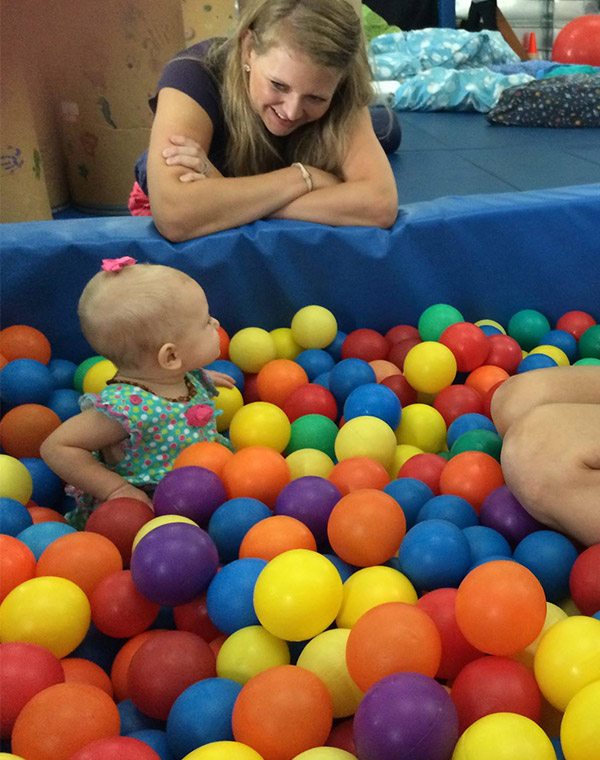Occupational Therapy
Our occupational therapists help children succeed in meeting the daily occupations of childhood: play, school, and self-help skills. Our therapists work with children on a variety of skills through play in a sensory-rich environment. Each child’s special interests and abilities are valued and used to create fun and motivating environment to grow and learn.

Who This Therapy is For?
Occupational therapy at Emerge can support children with or who are experiencing:
-
-
- Sensory processing deficits or differences
- Difficulties with behavioral modulation and emotional regulation
- Dyspraxia (difficulties with coordination)
- Autism
- ADHD
- Difficutlies with executive functioning
- Learning disabilities
- Differences with play, social skills, coordination, attention, handwriting and/or motor skills.
-
Additional Specialty Services
Infant Therapeutic Services
Our therapists are equipped with the tools to help support infants reach their early developmental milestones (such as rolling, sitting upright, or crawling), torticollis and/or plagiocephaly, feeding difficulties, tongue and lip ties, parent/child bond, and more. Emerge offers a variety of programs for infants including one-on-one sessions, consultative services, infant massage training, and parent workshops.
Parent Coaching
A parent coach can help you navigate the twists and turns of parenting a neurodivergent child, school concerns, IEPs, home routines, challenging behaviors, and therapy carryover at home. They provide you with practical tools, tailored strategies, and expert advice, designed specifically to meet your family’s unique needs!
Interactive Metronome
Interactive Metronome® is an evidence-based program that combines a musical metronome with a computer-based software program and is guided and individualized for each client by a therapist to strengthen the neural timing network within the brain to support improvements in cognitive function, academic performance, athletic performance, and more.
Feeding Therapy
Feeding Therapy with our occupational therapists primarily use the SOS Approach to Feeding to support children who have significantly restricted diets. SOS works to increase the range of foods that a child will eat. This program can be implemented in individual or group settings and includes a significant parent involvement and education component to ensure home carryover.
Floortime Coaching
Floortime is a developmental approach to supporting children in their emergence into a social world through play, utilizing the power of their relationships with caregivers and therapists, and emphasizing the child’s individual differences as the catalyst for growth and change. Since the child-caregiver relationship is a key part of Floortime, caregiver coaching can be a powerful therapeutic intervention.
Customized Interventions
Click to learn more about all of the customized interventions, programs, and trainings our team has to offer!

Our Approach (methodology)
Emerge is a neurodiversity-affirming clinic. We are play-based, child-led, and use a “sensory lense” to help guide treatment. Each of our locations offers a wide variety of sensory-rich environments. Regardless of the type of therapy, our goal is to find fun and motivating ways to encourage each child. We carefully consider their special interests and unique skill sets when planning treatment sessions. Nearly all our staff have completed some level of training within the DIR/Floortime structure and incorporate concepts and principles into daily practice.
Learn More
Does Your Child Have Delays in Motor Skills?
AT 9 MONTHS, DOES YOUR CHILD:
- Sit independently.
- Move about room (roll, crawl on stomach, creep on hands and knees).
- Eat mashed table food without gagging.
AT 12 MONTHS, DOES YOUR CHILD:
- Pull to stand and cruise (may walk independently).
- Pick up small objects between thumb and index finger.
- Feed self with fingers.
AT 18 MONTHS, DOES YOUR CHILD:
- Build a 3-4 block tower.
- Feed self with little help.
- Walk confidently.
- Walk up and down 3 steps.
AT 24 MONTHS, DOES YOUR CHILD:
- String large beads.
- Remove simple clothing.
- Jump with both feet clearing floor.
AT 36 MONTHS, DOES YOUR CHILD:
- Independently dress except for fasteners.
- Draw a circle and cross.
- Ride a tricycle.
- Catch an 8” ball.
AT 48 MONTHS, DOES YOUR CHILD:
- Draw simple pictures.
- Cut on a line.
- Gallop.
AT 60 MONTHS, DOES YOUR CHILD:
- Cut out simple shapes.
- Color within the lines.
- Skip.
Understanding Sensory Processing Disorders
For all of us, our mind and body are delicately connected. Every thought, feeling and action we experience occurs through complex interactions of our brain. How we process sensory information has a major impact on our behavior. The slightest change in our brain processes can influence how we cope with everyday life.
Children inherently want to play, learn, cooperate, make friends and be successful. This internal drive can become disrupted when certain areas of the brain that process sensory information do not seem to be making the connection that they should be. The behaviors that result can confuse, frustrate and sometimes anger parents, teachers, day-care providers and baby-sitters. But most importantly, they impact the child’s ability to feel comfortable in and successfully navigate their world.
Most children with sensory problems are born with these challenges. That’s why early intervention is so important for infants and toddlers. Treating ‘little’ issues early prevents them from becoming big issues later on.
Understanding how impaired sensory processing may be underlying a child’s struggle is the first step in a family’s journey toward helping the child.
Does Your Child Have a Sensory Processing Disorder?
- Was unusually fussy, difficult to console, or easily startled as an infant. Is over-sensitive to stimulation–over-reacts to touch, movement, tastes, sounds, or odors.
- Has difficulty regulating sleep/wake cycle–settling for sleep, staying asleep, and waking without irritability.
- Has difficulty with everyday activities like eating, sleeping, brushing their teeth or getting dressed.
- Is easily overwhelmed in group situations, which may result in overexcitement, meltdowns or shutting down.
- Can’t get “enough” sensory input: touching, squeezing, moving, bouncing or mouthing.
- Has poor muscle tone, fatigues easily, leans on people, or slumps in a chair. Uses an inappropriate amount of force when handling objects, coloring, writing, or interacting with siblings or pets.
- Was slow to roll over, creep, sit, stand, or walk, or to achieve other motor milestones.
- Is clumsy, falls frequently, bumps into furniture or people, and has trouble judging position of body in relation to surrounding space.
- Has difficulty learning new motor tasks; experiences frustration when attempting to follow instructions or sequence steps for an activity.
- Avoids playground activities, physical education class, and/or sports.
- Does not enjoy age-appropriate motor activities such as jumping, swinging, climbing, drawing, cutting, assembling puzzles, or writing.
- Difficulty learning how to play or get along with other children. Difficulty with or avoids drawing, cutting, writing activities.
- Challenges in school, including attention, organizational perception and listening skills.
Books About Processing/Sensory Integration
Sensory Integration and the Child: 25th Anniversary Edition (1979, revised 2005) by A. Jean Ayres. Updated classic by Dr. Jean Ayres, who developed the theory of sensory integration and many of the treatment foundations. This book offers extensive information about sensory integration with case examples.
The Sensory-Sensitive Child: Practical Solutions For Out-of-Bounds Behavior (2004) by Karen A. Smith. Written by two psychologists, who are also mothers of children with sensory processing disorders, this book is strong in addressing the behavioral impact of sensory processing disorders (not just those with hypersensitivity).
Sensational Kids: Hope and Help for Children with SPD (2006) by Lucy Jane Miller. In-depth, state of the art information of sensory processing disorder. Includes medical and scientific explanations as well as real life examples of children with Sensory Processing Disorders.
The Out-Of-Sync Child: Recognizing and Coping with Sensory Integration Dysfunction (1998; revised 2005) by Carl Kranowitz. An easy-to-read classic written by a preschool music and movement teacher. Includes detailed checklists. Carol has given one-day workshops in our areas several times.
The Out-Of-Sync Child has Fun (2003; revised 2006) by Carol Kranowitz. A collection of sensory based activities to do at home.
Building Bridges through Sensory Integration (2003) by Ellen Yack, Shirley Sutton, and Paula Aquilla. Practical book specifically oriented to children with autism and other pervasive developmental disorders. Offers specific strategies for challenging behaviors and self-help skills.
Tool Chest for Teachers, Parents and Students Handbook by Diane Henry. Easy to use reference, primarily geared to school support and adaptations. Sensational Kids by Lucy Jane Miller
Raising Your Sensory Smart Child: The Definitive Handbook for Helping Your Child with Sensory Integration Issues (2005) by Lindsey Biel and Nancy Peske. Written by a parent of a child with Sensory Processing Disorder and a pediatric occupational therapist, this book includes practical ideas for activities.
Sensory Secrets: How to Jump-Start Learning in Children (2001) by Catherine Schneider. Introductory book to understanding sensory systems and impact on learning.
Too Loud, Too Bright, Too Fast, Too Tight: What to Do It You Are Sensory Defensive in an Overstimulating World (2002) by Sharon Heller. An overview of sensory defensiveness and treatment options.

